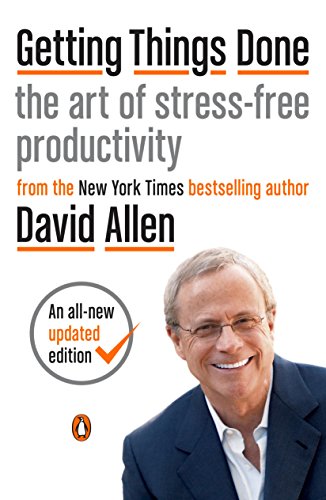Getting Things Done
David Allen, 2015, etting Things Done: The Art of Stress-Free Productivity
Book Image
More info
In today’s world, yesterday’s methods just don’t work. In Getting Things Done, veteran coach and management consultant David Allen shares the breakthrough methods for stress-free performance.
Allen’s premise is simple: our productivity is directly proportional to our ability to relax.
Only when our minds are clear and our thoughts are organized can we achieve effective productivity and unleash our creative potential.
The primary reason for organizing is to reduce cognitive load: to eliminate the need to constantly be thinking, What do I need to do about this?
Overview
- If we don’t appropriately manage the
open loopsin our life, our attention will get pulled. Overwhelmcomes from:- not clarifying what your intended outcome is,
- not deciding what the very next action is, and
- not being aware of your outcome and next-previous-action.
- You need to transform all the
stuffyou attract and accumulate into a clear inventory.
Structure
Getting things done requires two basic components:
Outcome: Defining what “done” meansAction: What “doing” looks like
We need some real metrics to feed our decision-making and be aware to where we are going.
You need to control commitments, projects, and actions in two ways:
Horizontally. Maintaining coherence across all the activities in which you are involvedVertically. Managing thinking, development, and coordination of individual topics and projects.
Five tips
Here are a few takeaways and tactics:
Done
Getting things done requires defining what done means and what doing looks like.
What is
done? What isdoing?
We need to transform all the ‘stuff’ we attract and accumulate into a clear inventory of meaningful actions, projects, and usable information.
Attention
Mastering your workflow involves capturing what has your attention, clarifying what it means, putting it where it belongs, reviewing it frequently, and engaging with it.
How de you see the world? What is your
narrative?
You must use your mind to get things off your mind and focus, if not: confussion and with confussion comes very bad decision-making.
Until your thoughts have been clarified and decisions have been made (and create a
pointer) your brain can’t give up the job.
pointer: decision, processes, targets, outocmes are data, information. The resulting data must be stored in a system that you absolutely know you will access and think about when you need to.
Now!
If an action will take less than two minutes, it should be done at the moment it is defined.
Save energy, do it now!
Anxiety
Anxiety and guilt don’t come from having too much to do; it comes from breaking agreements with yourself.
Your mind is for having ideas, not for holding them.
It’s a waste of time and energy to keep thinking about something that you make no progress on.

